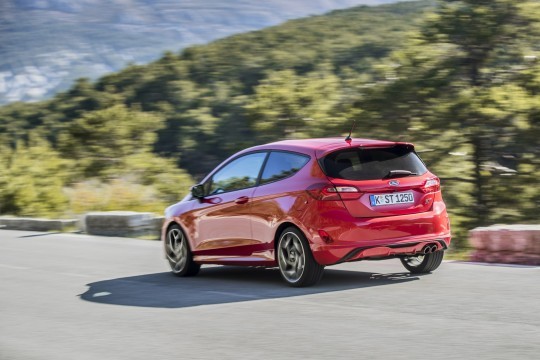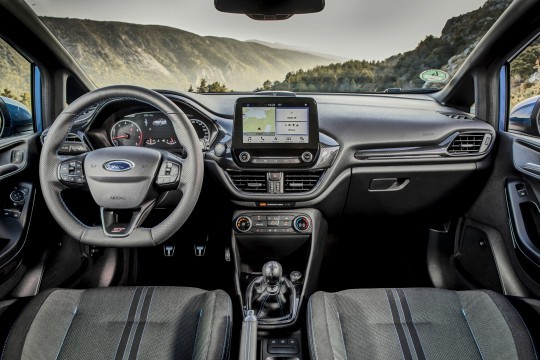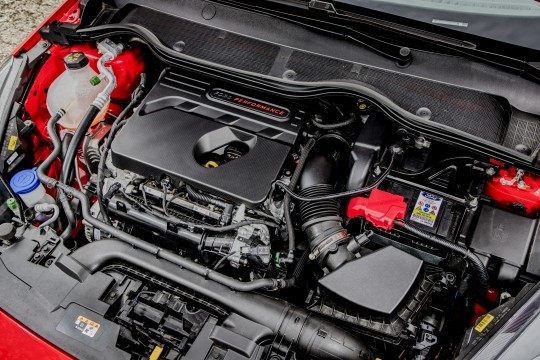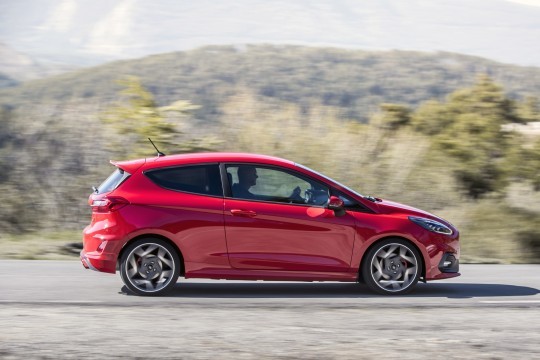We are young, we are fresh and daring, but are we really better than our parents? Research on how satisfied the new generations are about their lives when compared to those who raised them often leads to worrying conclusions for the youngsters. So what happens when we use the 2018 Ford Fiesta ST as a case study?
The retired Fiesta ST outshined the obvious limitations of is B-segment status, proving one of the best hot hatches out there. However, Ford Performance engineers didn’t rest on the lift-off oversteer laurels of the old car when honing the newcomer. Instead, they went back to the drawing board and reinvented the tech side of the pocket rocket.
In the process, the compact speeder lost one or two of its cylinders, as it’s now powered by a three/two-pot (more on this below), while its rear axle comes with something called banana springs. On paper, this sounds like a curious recipe for an uber-fun little car with such big shoes to fill and we recently got behind the wheel to see how the thing tastes.
It’s difficult to leave prejudice behind when approaching the 2018 Fiesta ST, especially after Renault’s attempt to reinvent the brilliant Clio RS by going turbo and only offering paddle shifters failed to deliver on its promises.
Truth be told, the 2018 Ford Fiesta ST isn’t striking to behold if you’re already familiar with the new Fiesta, not least because the more affordable ST Line trim level of the standard car gets most of the visual bits offered on the hot hatch.
Then again, just like people have learned to live with this in the case of fast-looking Audis, BMWs and Mercs, it shouldn’t be an issue for the Blue Oval.
Even so, the proper ST gets a bespoke front grille mesh, along with gray surrounds for the fog lights.
In fact, if you zoom in on the car, you’ll notice that the slightly aggressive front apron is joined by a rear diffuser and a tailgate spoiler in its aerodynamic mission. And while these don’t go as far as generating negative lift (the thing we like to call downforce), they do reduce lift, so you can hoon this thing all the way to its 232 km/h (144 mph) without any worries. Interestingly, all the added rear end spice doesn’t quite manage to make the posterior of the thing look as enticing as its front section.
When ordering a Fiesta ST, you get to choose between 17- and 18-inch alloys. And while our tester was gifted with the latter, Ford engineers promptly stated that the smaller ones don’t make too much of a difference in terms of handling. Since the car is positioned as an overall performer rather than an all-out track-savvy effort, we’d choose the 17-inch rollers, in the name of ride comfort.
Remember when we drove the third-generation Focus RS? That was the modern fast Ford that taught us to expect no more than a few sporty cabin gimmicks when it comes to hot hatches. So we weren’t surprised by the fact that the interior treatment for the Fiest ST uses a similar approach.
To be more precise, the sporty cabin bits include the dashboard instruments, the pedals, the gear shifter’s knob and the steering wheel. The last feels a bit large for the machine around it, but it’s not difficult to understand why Ford didn’t choose a smaller diameter for the wheel. You see, the steering of the ST needs just two turns to go from lock to lock and a smaller unit would’ve made it too sensitive.
We’ve saved the Recaro front seats for last, but not because they’re the best. On the contrary – as with any Recaros fitted to budget go-fast machines, these aren’t friendly enough. In this case, the seat bases hug you a bit too firmly, limiting the otherwise respectable daily driver appeal of the car.
Nevertheless, if you climb into the back seat, you’ll notice that the accommodation is decent, at least for those under 1.80 meters. Keep in mind that, unlike the Volkswagen Polo GTI, which only comes in five-door form, the Fiesta ST can also be had with just three-doors (the latter form was the one used for the test car).
On the infotainment front, the Sync 3 finally allows users to enjoy the experience, while the B&O Play (a Bang & Olufsen budget sub-brand) audio system is the best in the segment.
But enough about the static bits, the time has come to bring the three-cylinder 1.5-liter EcoBoost motor to life. Press the start button and the svelte engine will deliver a surprisingly meaty soundtrack, as sampled in the video below.
When was the last time you heard an aficionado declaring his or her lust for a three-cylinder engine? Well, the Fiesta ST delivers just such an occasion and that’s because its real-life face matches its hefty output figures.
The 1.5-liter mill produces 200 hp and 290 Nm of twist. These are the same numbers as those of the replaced car’s 1.6-liter turbo four (when the 20-second Overboost feature was engaged), but the muscle band is now richer.
Oh, and when you’re simply cruising along, the little engine will shut down one of its cylinders, leaving you in… motorcycle mode. The two-cylinder mode of the engine is designed to kick in when you’re cruising along and the good part is that you don’t feel the cylinder deactivation feature at work.
As for the efficiency, the carmaker quotes an average value of 6l/100 km (NEDC) and we have to mention that, with a sensible right foot, that figure can be achieved in the real world. Of course, nobody buys a hot hatch to protest against gas prices, but you get the idea – the Fiesta ST can be fuel efficienct when this is desired.
Despite the fact that the engine sounds quite pleasant both from outside and from inside the car, Ford chose to boost the in-cabin aural experience through the speakers of the car. Nevertheless, the carmaker insists that the added decibels come from a real-time amplification rather than being a recording. And we have to admit that the result felt less artificial than in the case of BMW models, for instance. As such, we won’t complain about this feature.
The engine pulls really well (just don’t insist on taking it past 5,000 rpm), while turbo lag is kept on a leash, so you’ll be able to enjoy the ST throughout the rev range. In fact, the only time when we felt the influence of the cylinder cut was when we lifted off the throttle – the counterbalance work required to allow the three-cylinder to run smoothly means the revs don’t drop as quickly as in the case of a four-pot. Nevertheless, the motor likes to rev, so it will keep you engaged.
As for the 1.5L EcoBoost’s partner in crime, namely a six-speed manual, we’re glad to have such a toy at our disposal. The shifts are short, but the operation is a bit notchy. And while in maximum attack mode, we did find it a bit difficult to throw the lever from second to third without fearing that fifth would have its way with us. Overall, the six-speed manual, which is the only tranny offered on the 2018 Fiesta ST, delivers an enjoyable experience, though.
Speaking of which, the pedals have a bit of an unusual position – the front wheel arch is a bit intrusive, sending the clutch a bit towards the center of the footwell, a bit like in the case of the Lamborghini Gallardo (how’s that for an argument while you’re out with your mates?). And the positioning of the gas and throttle means that heel-and-toe-ing doesn’t come easy. Nevertheless, once you get used to these little quirks, you’ll have no problem doing the dance in the ST.
However, the icing on the ST cake is the handling. And, as it turns out, this is a fruit cake, since we’re dealing with those banana springs.
It all starts with the chassis, as the body-in-white of the ST is 14 percent more rigid than that of the standard car. This spicy compact talks to the road via directionally wound springs, which deliver a stabilizing lateral force onto the rear wheels while doing their normal job.
This means Blue Oval engineers could skip the uber-rigid suspension mounting bushes usually found on hot hatchbacks that use torsion beam rear suspensions. As such, the softer bushes mean the ride isn’t compromised, while handling remains precise.
For the record, Ford, along with a few other carmakers, such as Citroen, have been playing the banana spring card for years, but the Ford Performance engineers, together with the company’s PR department, have upped the ante for the Fiesta ST. Even so, the spring rates are a tad more aggressive than those on the old model, so it’s up to those bushes to save the day from those who seek comfort.
Then we have the Tenneco-supplied selective dampers. These aren’t adaptive, but feature double valves for filtering out high- and low-frequency inputs, thus outperforming standard passive shock absorbers.
To avoid torque and bump steer, the Ford Peformance people came up with a bespoke front hub design and we haven’t even gotten to the end of the tech delicacies list.
You see, the carmaker deemed the otherwise brilliant Michelin Pilot Sport 4S tires insufficient for the requirements of the 2018 Fiesta ST. Instead, they went for the even stickier Pilot Super Sports rubber.
And we could instantly feel that grip while pushing the car hard on the Southern French roads that were chosen for the international launch of the model.
The twisty, elevation-playful course, which is sprinkled with both tight and high-velocity corners, allows one to fully exploit the dynamic potential of the Ford Fiesta ST.
The steering has to be the least fun part of the car – while you can get used to its rather agitated on-center feel, there’s not much one can do regarding missing some extra feedback.
Then again, if we focus on the overall package, the 2018 Fiesta ST proves hugely entertaining. From the way it incites while driven in tight city areas to its way of answering to one’s open road hooning needs, this little Ford is tiny no more when it comes to delivering kicks.
So whether you’re sprinting at nine out of ten or going all out, the machine will suit your needs just fine.
Thankfully, the rear end playfulness that made the old car such a doll is still here. Nevertheless, with that complex rear axle design and the super-grippy tires, you’ll have to work harder to get to it.
It feels like the new chassis setup expands the at-the-limit interval, a bit like an older friend asking you if you’re sure you want to get that hammered tonight before you two step into the next bar.
The current Fiesta is a clear upmarket move and this is reflected in the added sophistication of the ST. The rebel side of the car is now lurking behind a friendly side that will allow any driver to extract the performance. So while the ex-generation model was a purer proposal handling-wise, the new one is more versatile.
So, can the tiny beast be used as a daily driver? While the ride will eventually show its limits, the answer is yes.
Then again, as in the case of the Focus RS and its Drift Mode, the new Fiesta ST comes with a driving mode that should only be used on the circuit (shhh!). I’m referring to the Track Mode, which can be accessed using a rather awkwardly-placed button on the center console.
Sharing the car with the Normal and the Sport driving modes, Track is here to let you go crazy without fully putting the Electronic Stability Control to sleep. And it’s well-calibrated, leaving you enough room for a bit of lift-off oversteer play.
As for straight-line shenanigans, the same Quaife limited-slip differential that pulls you out of the corners like magic will deliver surprising traction for a front-paw machine.
Turn to the Launch Control feature (enable it from the menu, mash the clutch, engage first, mash the throttle and release the pedal on the left) and you’ll fully feel the 6.5s status of the car.
In fact, the clip below brings you a sample of just how quickly the Ford Fiesta ST can get off the line.
The said LSD, a rare feat in the hot hatch world, which is dominated by electronic surrogates (this Ford also applies the brakes on the inner rear wheel while cornering), is part of a Performance Package that is optional in some markets. Nevertheless, ordering the Fiesta ST without it would be a shame.
Speaking of pricing, the 2018 Ford Fiesta ST does deserve the value-for-money label, undercutting both the Renault Clio RS and the (admittedly more sophisticated) VW Polo GTI. On the German market, the Blue Oval machine comes with a starting price of €22,100 (19% VAT included).
So while the new Fiesta ST isn’t perfect, it certainly deserves a place among the best hot hatches out there. This compact performer will make you happy.












